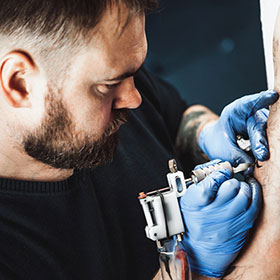Yes, spine tattoos can hurt. The pain varies for each person.
Getting a tattoo on your spine can be a unique experience. The spine is a sensitive area with less fat and more bone. This makes the process potentially more painful than other locations. People often wonder about the level of pain they might endure.
While pain tolerance differs, understanding what to expect can help. This blog will explore the factors influencing pain during spine tattoos. We’ll discuss common experiences and tips to manage discomfort. Whether you’re considering your first tattoo or adding to your collection, knowing the facts can prepare you better. Let’s dive into the world of spine tattoos and their pain levels.
Introduction To Spine Tattoos
Spine tattoos are very popular. They look bold and unique. Many people find them beautiful. Celebrities often have them. This makes others want them too. Spine tattoos can be small or large. They can be simple or detailed. Many people choose designs with deep meaning. Others pick designs they just like.
Spine tattoos can be tricky. The spine is a sensitive area. This can make the tattoo more painful. Also, the spine has many bones. This can cause more discomfort. It is important to choose a skilled artist. They can help make the process easier. Healing can take longer too. It is important to follow care instructions. This helps avoid infections.
Pain Factors
Everyone feels pain differently. Some people can handle more pain. Others feel pain strongly. This is called individual pain tolerance. It can vary a lot. A person with high pain tolerance may feel less pain. Someone with low pain tolerance may feel more pain. Each person’s experience will be unique.
Smaller tattoos may hurt less. Larger tattoos can be more painful. Detailed designs may take longer. More time means more pain. Simple designs might hurt less. Complex designs can increase pain. Think about the size and detail of your tattoo.
Anatomy Of The Spine
The spine is a vital part of our body. It supports our back and helps us move. It is made up of many small bones called vertebrae. These bones are stacked on top of each other. The spine also has many nerves. These nerves send signals to the brain.
Some parts of the spine are very sensitive. The neck and lower back are two examples. These areas have many nerve endings. They can be very painful if touched or hurt. Tattoos in these areas might hurt more.
The spine has many nerve endings. These nerve endings can feel pain. When a needle touches them, it can hurt a lot. Tattoos on the spine can feel more painful because of this. The middle of the back might hurt less. This is because it has fewer nerve endings.
Artist’s Technique
Wondering about spine tattoos? They tend to hurt more than other spots due to the proximity to bones and nerves. Pain varies by person, but expect some discomfort.
Needle Depth
The depth of the needle matters a lot. If the needle goes too deep, it can cause more pain. A shallow needle may not hurt as much. Experienced artists know the right depth. They adjust it for each part of the spine. This helps in reducing pain.
Tattooing Speed
The speed of tattooing also affects pain. Fast tattooing can be more painful. Slow and steady tattooing can feel less painful. Skilled artists find a balance. They work at a pace that is comfortable. This makes the process easier to bear.
Pre-tattoo Preparation
Think about the tattoo you want. Visualize it on your skin. Breathe deeply and stay calm. Trust your tattoo artist. They know their job well. Be ready for some pain. It’s part of the process. Stay positive and excited. You’re getting new art!
Stay hydrated before your appointment. Drink lots of water. Avoid alcohol and caffeine. They can make the pain worse. Eat a good meal before you go. Full stomach helps. Bring music or a book. Distractions can help. Tell your artist if you need a break. They understand. Breathe deeply to stay calm. Pain will pass soon.
During The Tattoo Session
The tattoo artist will prepare your skin. They will clean and shave the area. The artist will then outline the design. This can be a bit uncomfortable. The spine is a sensitive area. You might feel a buzzing sensation. Some parts may hurt more than others. It depends on your pain tolerance.
Take deep breaths to stay calm. Relaxing helps reduce pain. Bring a friend for support. Listen to music or a podcast. Distract your mind. Avoid tensing your muscles. This can make the pain worse. Tell your artist if you need a break. They will understand. Stay hydrated before your session. Drink water to keep your body in good shape.
Post-tattoo Care
A spine tattoo needs special care. The skin on the spine is sensitive. It may take longer to heal. Keep the tattoo clean and dry. Use mild soap to wash it. Pat it dry gently.
Avoid tight clothes. They can rub against the tattoo. This can cause irritation. Apply a thin layer of healing ointment. Do this twice a day. Avoid direct sunlight. It can fade the tattoo.
Pain relief is important. Use ice packs to reduce swelling. Over-the-counter pain relief can help. Follow the dosage instructions. Avoid alcohol. It can thin the blood. This may increase pain.
Rest is crucial. Avoid heavy lifting. Do not stretch the skin too much. This can cause more pain. Stay hydrated. Drink plenty of water. This helps the body heal faster.
Personal Experiences
Many people say spine tattoos hurt a lot. The pain is often sharp and intense. Some describe it as a burning feeling. Long sessions can make the pain worse. Others feel the pain is less severe. They compare it to small pinches. Pain tolerance varies from person to person. Experiences can be different. Some feel more pain at the start. Others feel pain throughout.
Spine tattoos are usually more painful. Compared to other areas, the spine is sensitive. The skin is close to the bone. This makes it hurt more. Arm tattoos are less painful. The muscle and fat provide cushion. Rib tattoos are also very painful. Similar to the spine, the ribs have less cushion. Each person’s pain level is unique. Some handle pain better than others.
Conclusion
Spine tattoos can be painful, but many people still get them. Pain varies based on personal tolerance. Some find it uncomfortable, others manage well. Proper care after the tattoo helps reduce discomfort. Choosing a skilled artist ensures a better experience.
Consider your pain threshold before deciding. Remember, the beauty of the tattoo lasts a lifetime. Be prepared and make an informed choice.

